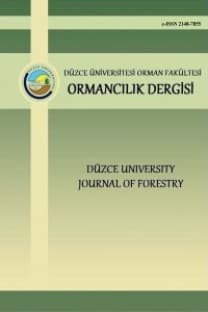Masif ve Lamine Ağaç Malzemelerin Isıl Genleşme Katsayıları Üzerine Karşılaştırmalı Bir Çalışma
Bu çalışmada, kayın (Fagus orientalis L.), kavak (Populus x euramericana I-214) ve okaliptüs
Anahtar Kelimeler:
Isıl genleşme katsayısı, lamine ağaç malzeme, masif ağaç malzeme
A Comparative Study on the Coefficient of Thermal Expansion of Solid and Laminated Wood Materials
In this study, the coefficients of thermal expansion of solid wood and laminated wood materials preparedfrom beech (Fagus orientalis L.), poplar (Populus x euramericana I-214) and eucalyptus (Eucalyptus grandisW. Hill ex Maiden) species were determined. The experiments were made on the sapwood and heartwood ofsolid wood material, separately. Laminated wood materials were produced from 3 mm thickness rotary peeledveneer using UF (urea-formaldehyde) and PF (phenol-formaldehyde) adhesive. The tests were performedbetween -10 and +40 ºC temperature interval. In tangential direction, the lowest coefficient of thermal expansionwas measured on the poplar heartwood (1.88x10–5 ºC–1) and the highest coefficient of thermal expansion wasmeasured on the laminated wood made from eucalyptus used PF (4.66x10–5 ºC–1). The results showed thatlaminated materials produced from poplar wood has higher coefficient of thermal expansion than solid poplarwood. The differences between solid and laminated wood from the beech and eucalyptus weren’t statisticallysignificant.
___
- Anonymous, 2012. Linear Coefficient of Thermal Expansion, http://www.ndt-ed.org, (Son erişim: 13.05.2012)
- Bal BC, Bektaş İ ve Kaymakçı A, 2011. Sedir (Cedrus Libani A.Richard) Odununun Bazı Önemli Mekanik Özellikleri ve Bu Özelliklerin Tam Kuru Yoğunlukla İlişkisi, I. Ulusal Akdeniz Orman ve Çevre Sempozyumu, Bildiriler kitabı, S: 1150.
- Bao F, Fu F, Choong E T and Hse C, 2001. Contribution Factor of Wood Properties Of Three Poplar Clones To Strength Of Laminated Veneer Lumber, Wood and Fiber Science, 33 (3):345-352.
- Baştürk MA, 2007 Thermal Linear Expansion of Oriented Strandboard, KSÜ Fen ve Mühendislik Dergisi, 10 (1): 85-88.
- Burdurlu E, Kılıç M, İlce A C ve Uzunkavak O, 2007. The Effects of Ply Organization and Loading Direction on Bending Strength and Modulus of Elasticity in Laminated Veneer Lumber (LVL) Obtained From Beech (Fagus orientalis L.) and Lombardy poplar (Populus nigra L.), Construction and Building Materials 21: 1720–1725.
- Green D W, Winandy J E and Kretschmann D E, 1999. Mechanical Properties of Wood, Wood handbook, Wood as Engineering Material. FPL, 11-2, Madison.
- Bozkurt Y ve Göker Y, 1996. Fiziksel ve Mekanik Ağaç Teknolojisi, İÜ, Orman Fakültesi Yayınları, Üniversite Yayın No: 3944, İstanbul.
- Keskin H, 2001. Lamine Masif Ağaç Malzemelerin Teknolojik Özellikleri ve Ağaç İşleri Endüstrisinde Kullanım İmkanları, Doktora Tezi, Gazi Üniversitesi, Fen Bilimleri Enstitüsü, Ankara.
- Örs Y ve Keskin H, 2001. Ağaç Malzeme Bilgisi, Gazi Üniversitesi Ders Kitabı, S:77, Ankara.
- Rowell M R, 2005. Moisture Properties, Handbook of Wood Chemistry and Wood Composites, P:77.
- Shukla S R and Kamdem P D, 2009. Properties Of Laboratory Made Yellow Poplar (Liriodendron Tulipifera) Laminated Veneer Lumber: Effect Of The Adhesives, Eur. Journal. Wood Product 67: 397–405.
- Simpson W and Tenwolde A, 1999. Physical Properties and Moisture Relations of Wood, Wood handbook, Wood as Engineering Material. FPL, 3-21, Madison.
- Simpson W T, 2001. Properties of Wood Related to Drying, USDA Agricultural Handbook AH-188: Dry Kiln Operator's Manual.
- ISSN: 2148-7871
- Yayın Aralığı: Yılda 2 Sayı
- Başlangıç: 2005
- Yayıncı: Haldun Müderrisoğlu
Sayıdaki Diğer Makaleler
Ahmet Ender OKUTAN, Gülden ÇAVUŞ
Orman Ürünleri Sanayinde Sosyal Sorumluluk: Türkiye’nin 1000 Büyük Sanayi Kuruluşu Örneği
Akif KETEN, Zeynel ARSLANGÜNDOĞDU, Erdal SELMİ
Türkiye Ormancılığı İçin Sürdürülebilir Orman Yönetimi Ölçütlerinin Belirlenmesi
Organik Ürün Olarak Doğa Mantarları
Merağa İli (İran) Turizm Potansiyelinin A’WOT Analizi ile Değerlendirilmesi
Parvin HEYDARZADEGAN, Mükerrem ARSLAN
Masif ve Lamine Ağaç Malzemelerin Isıl Genleşme Katsayıları Üzerine Karşılaştırmalı Bir Çalışma
Bekir Cihad BAL, İbrahim BEKTAŞ, Ferhat ÖZDEMİR
Paralel Başlıklı Ahşap Kafes Kirişlerin Sonlu Elemanlar Yöntemi İle Analizi
Ergün GÜNTEKİN, İbrahim Halil Başboğa, Tuğba YILMAZ
